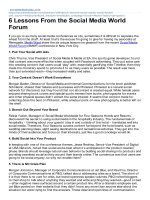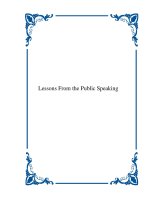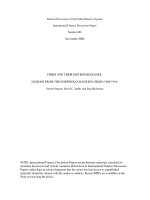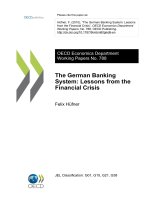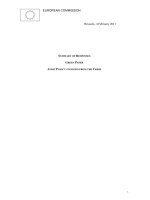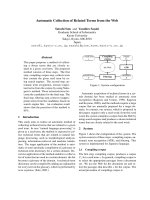Lessons from the Field pptx
Bạn đang xem bản rút gọn của tài liệu. Xem và tải ngay bản đầy đủ của tài liệu tại đây (539.21 KB, 93 trang )
This document and trademark(s) contained herein are protected by law as indicated in a notice appearing later in
this work. This electronic representation of RAND intellectual property is provided for non-commercial use only.
Unauthorized posting of RAND PDFs to a non-RAND Web site is prohibited. RAND PDFs are protected under
copyright law. Permission is required from RAND to reproduce, or reuse in another form, any of our research
documents for commercial use. For information on reprint and linking permissions, please see RAND Permissions.
Limited Electronic Distribution Rights
This PDF document was made available from www.rand.org as a public
service of the RAND Corporation.
6
Jump down to document
THE ARTS
CHILD POLICY
CIVIL JUSTICE
EDUCATION
ENERGY AND ENVIRONMENT
HEALTH AND HEALTH CARE
INTERNATIONAL AFFAIRS
NATIONAL SECURITY
POPULATION AND AGING
PUBLIC SAFETY
SCIENCE AND TECHNOLOGY
SUBSTANCE ABUSE
TERRORISM AND
HOMELAND SECURITY
TRANSPORTATION AND
INFRASTRUCTURE
WORKFORCE AND WORKPLACE
The RAND Corporation is a nonprofit research
organization providing objective analysis and effective
solutions that address the challenges facing the public
and private sectors around the world.
Visit RAND at www.rand.org
Explore the RAND-Qatar Policy Institute
View document details
For More Information
Purchase this document
Browse Books & Publications
Make a charitable contribution
Support RAND
This product is part of the RAND Corporation technical report series. Reports may
include research findings on a specific topic that is limited in scope; present discus-
sions of the methodology employed in research; provide literature reviews, survey
instruments, modeling exercises, guidelines for practitioners and research profes-
sionals, and supporting documentation; or deliver preliminary findings. All RAND
reports undergo rigorous peer review to ensure that they meet high standards for re-
search quality and objectivity.
RAND-QATAR POLICY INSTITUTE
TECHNICAL REPORT
Lessons from the Field
Developing and Implementing the
Qatar Student Assessment System,
2002–2006
Gabriella Gonzalez
t
Vi-Nhuan Le
t
Markus Broer
t
Louis T. Mariano
J. Enrique Froemel
t
Charles A. Goldman
t
Julie DaVanzo
Prepared for the Supreme Education Council
The RAND Corporation is a nonprofit research organization providing objective analysis
and effective solutions that address the challenges facing the public and private sectors
around the world. RAND’s publications do not necessarily reflect the opinions of its
research clients and sponsors.
R
®
is a registered trademark.
© Copyright 2009 RAND Corporation
Permission is given to duplicate this document for personal use only, as long as it is unaltered
and complete. Copies may not be duplicated for commercial purposes. Unauthorized
posting of RAND documents to a non-RAND Web site is prohibited. RAND
documents are protected under copyright law. For information on reprint and linking
permissions, please visit the RAND permissions page (
permissions.html).
Published 2009 by the RAND Corporation
1776 Main Street, P.O. Box 2138, Santa Monica, CA 90407-2138
1200 South Hayes Street, Arlington, VA 22202-5050
4570 Fifth Avenue, Suite 600, Pittsburgh, PA 15213-2665
RAND URL:
To order RAND documents or to obtain additional information, contact
Distribution Services: Telephone: (310) 451-7002;
Fax: (310) 451-6915; Email:
The research described in this report was prepared for the Supreme Education Council and
conducted within the RAND-Qatar Policy Institute and RAND Education, programs of
the RAND Corporation.
Library of Congress Cataloging-in-Publication Data
Lessons from the field : developing and implementing the Qatar student assessment system, 2002-2006 /
Gabriella Gonzalez [et al.].
p. cm.
Includes bibliographical references.
ISBN 978-0-8330-4689-5 (pbk. : alk. paper)
1. Educational tests and measurements—Qatar. 2. Students—Rating of—Qatar. I. Gonzalez, Gabriella.
LB3058.Q38L47 2009
371.26'2095363—dc22
2009009273
iii
Preface
His Highness the Emir of Qatar sees education as the key to Qatar’s economic and social
progress. Long concerned that the country’s education system was not producing high-quality
outcomes and was rigid, outdated, and resistant to reform, the Emir approached the RAND
Corporation in 2001, asking it to examine the kindergarten through grade 12 (K–12) educa-
tion system in Qatar and to recommend options for building a world-class system consistent
with other Qatari initiatives for social and political change. In November 2002, the State of
Qatar enacted the Education for a New Era (ENE) reform initiative to establish a new K–12
education system in Qatar.
One component of ENE was the development of internationally benchmarked curricu-
lum standards in modern standard Arabic, English as a foreign language, mathematics, and
science subjects. ese standards are used in the Independent schools that have been developed
as part of the reform. Qatar also established a standardized, standards-based student assess-
ment system to measure student learning vis-à-vis the new curriculum standards among all
students in government-sponsored schools, including the Independent schools, the traditional
Qatar Ministry of Education schools, and private Arabic schools, which follow the Qatar Min-
istry of Education curriculum in a private-school setting. e development of a comprehensive
assessment system, its alignment with the standards, and its standardized administration to
the targeted students are vital components of ensuring the success of Qatar’s ENE reform. e
system allows parents to gauge the performance of different schools and allows policymakers
to monitor school quality.
From July 2002 to July 2005, RAND assisted in the implementation and support of the
ENE reform. e reform design and the results of the first two years of implementation are
reported in the RAND monograph Education for a New Era: Design and Implementation of
K–12 Education Reform in Qatar (Brewer et al., 2007).
is technical report describes work carried out as part of the larger RAND study. It
documents the development of the Qatar Student Assessment System (QSAS) with particu-
lar attention to its primary component, the Qatar Comprehensive Educational Assessment
(QCEA), expanding on the discussion of the assessment system in Brewer et al. (2007). Staff
of the Supreme Education Council’s (SEC’s) Evaluation Institute and the RAND Corpora-
tion collaborated on the QSAS design and implementation and jointly authored this report.
(Coauthors Markus Broer and Juan Enrique Froemel have since left the Evaluation Institute.)
is report should be of interest to education policymakers or test developers in other coun-
tries looking to develop standards-based assessments, as well as to researchers and practitioners
interested in recent education reforms undertaken in Qatar and in the Middle East region in
general.
iv Lessons from the Field: Developing and Implementing the Qatar Student Assessment System, 2002–2006
More detailed information about the reform can be found at the SEC Web site: www.
english.education.gov.qa (English version, with a link to the Arabic version).
is project was conducted under the auspices of the RAND-Qatar Policy Institute
(RQPI) and RAND Education in conjunction with Qatar’s Student Assessment Office. RQPI
is a partnership of the RAND Corporation and the Qatar Foundation for Education, Science,
and Community Development. e aim of RQPI is to offer the RAND style of rigorous and
objective analysis to clients in the greater Middle East. In serving clients in the Middle East,
RQPI draws on the full professional resources of the RAND Corporation. RAND Education
analyzes education policy and practice and supports implementation of improvements at all
levels of the education system.
For further information on RQPI, contact the director, Richard Darilek. He can be
reached by email at ; by telephone at +974-492-7400; or by mail
at P.O. Box 23644, Doha, Qatar. For more information about RAND Education, contact the
associate director, Charles Goldman. He can be reached by email at Charles_Goldman@rand.
org; by telephone at +1-310-393-0411, extension 6748; or by mail at the RAND Corporation,
1776 Main Street, Santa Monica, California 90401, USA.
v
Contents
Preface iii
Figures
vii
Tables
ix
Summary
xi
Acknowledgments
xvii
Abbreviations
xix
Glossary
xxi
CHAPTER ONE
Introduction 1
Background on Qatar’s Education System
1
e Context for Reforming Qatar’s K–12 Education System
2
Overview of the Education for a New Era Reform
3
Governance Structure of the Education for a New Era Reform
4
Supporting Accountability rough the Student Assessment System
5
Purpose, Approach, and Limitations of is Report
6
Organization of is Report
7
CHAPTER TWO
Design of the Qatar Student Assessment System: A Work in Progress 9
e QSAS Design as Initially Envisioned
9
Purpose and Uses of the QSAS
9
Format and Composition of the QSAS
10
QSAS and QCEA Development Issues: Turning Design into Practice
12
Where to Start?
12
Which Students Would Be Part of the QSAS?
12
What Would Be the Structure of the QCEA?
14
How Would QCEA Results Be Used?
14
In Which Language(s) Would the QCEA Be Administered?
15
What Would Be the Delivery Method of the QCEA?
16
Which Grades Would Be Tested by the QCEA?
17
CHAPTER THREE
Implementing the QCEA in 2004, 2005, and 2006: Test Development and
Administration
19
2004 QCEA: First Year of Standardized Testing
19
vi Lessons from the Field: Developing and Implementing the Qatar Student Assessment System, 2002–2006
Item Development 20
Developing the QCEA in 2005
22
Aligning the QCEA to the New Qatar Curriculum Standards
22
Changing the Format of the QCEA
23
Item Development
24
Administering the 2004 and 2005 QCEAs
25
Test Administration in 2004
25
Test Administration in 2005
27
CHAPTER FOUR
Scoring the QCEA and Reporting Results 29
Scoring the Tests and Reporting the Results from the 2004 QCEA
29
Scoring the Tests and Reporting the Results from the 2005 QCEA
31
Scoring the Tests and Reporting the Results from the 2006 QCEA
32
Comparing 2005 and 2006 QCEA Results by School Type
33
Arabic and English
35
Mathematics and Science
35
CHAPTER FIVE
Lessons Learned and Future Directions 37
Lessons Learned from Developing and Implementing the QSAS and QCEA
37
Separation of Standards Development and Assessment Development Hampered
Communication Around Alignment
37
e Timeline for Developing a Fully Aligned Standards-Based Assessment System Was
Too Short
38
Logistic and Administrative Constraints Often Took Precedence Over Substantive
Needs of the QCEA Testing Operation
39
Many Policies About Testing Did Not Consider Existing Research or Analysis
39
ere Was Insufficient Communication About the Purposes and Uses of Testing
40
Challenges at the Evaluation Institute Should Address
41
Assess Content from the Advanced Standards
41
Provide Accommodations or Alternative Assessments for Students with Disabilities
41
Use More Advanced Technologies
41
Communicate with the Public
42
Conduct Validity Studies
42
Finalize Policy Decisions in Designing Future QSAS Administrations
42
Concluding oughts
42
APPENDIXES
A. Assessment Elements Considered for the QSAS 45
B. Steps to Align Assessments with Curriculum Standards
49
C. Performance-Level Results of 2005 and 2006 QCEAs for Ministry of Education,
Private Arabic, and Independent Schools
55
References
65
vii
Figures
1.1. Organizational Structure of the Education for a New Era Reform, 2002–2006 4
3.1. Timeline for Alignment of 2005 QCEA with Qatar Curriculum Standards,
2003–2005
22
4.1. Percent Correct, QCEA Multiple-Choice Questions, 2004
30
ix
Tables
2.1. QSAS and QCEA Design Changes, 2004–2007 18
3.1. QCEA Test Development and Alignment, 2004–2007
25
3.2. 2005 QCEA Testing Times, by Subject and Grade
27
4.1. Student Performance-Level Expectations, Grade 4 Mathematics
32
4.2. QCEA Proficiency Levels and Reporting of Results, 2004–2007
33
4.3. Performance-Level Results of 2005 and 2006 QCEAs, by Subject and School
Type, Grades 4, 8, and 11
34
A.1. Components Considered for the QSAS
46
B.1. Summary of Alignment Audit for 2005 QCEA and Qatar Curriculum Standards
53
C.1. QCEA Performance Levels, Arabic, by School Type and Grade, 2005 and 2006
56
C.2. QCEA Performance Levels, English as a Foreign Language, by School Type,
2005 and 2006
58
C.3. QCEA Performance Levels, Math, by School Type, 2005 and 2006
60
C.4. QCEA Performance Levels, Science, by School Type, 2005 and 2006
62
xi
Summary
Background
e Arabian Gulf nation of Qatar has recently positioned itself to be a leader in education
reform. e country’s leadership has initiated a number of changes to Qatar’s kindergarten
through grade 12 (K–12) and higher education systems. In 2001, the Emir of Qatar, His
Highness Sheikh Hamad Bin Khalifa Al ani, asked RAND to help redesign the country’s
K–12 education system. RAND recommended that Qatar institute a comprehensive educa-
tion reform with a standards-based education system at its core. In 2002, implementation of
the reform initiative, Education for a New Era (ENE), began.
ENE is based on four core principles: variety in educational offerings, choice for parents
to select schooling options for their children, autonomy of newly opened schools, and account-
ability for all government-sponsored schools in Qatar, including newly developed Independent
schools, traditional public schools operated by the Qatar Ministry of Education, and private
Arabic schools that follow the Ministry of Education curriculum in a private-school setting.
Central to ENE was the development of internationally benchmarked curriculum stan-
dards in modern standard Arabic (fusHa), English as a foreign language, mathematics, and
science for students in grades K–12. e curriculum standards include both content stan-
dards, which note what students should be taught in each grade, and performance standards,
which note what students should know by the end of each grade. Curricula, assessments, and
professional development are aligned with and follow from the curriculum standards. In the
2004–2005 academic year, 12 Independent schools opened and began operating alongside
the traditional Ministry of Education schools. e Independent schools are governed by the
Supreme Education Council (SEC), which was established as part of the reform plan. Inde-
pendent schools follow the established curriculum standards, but principals of the schools
have more autonomy to make decisions about educational approach (e.g., curricula used in the
classrooms), staffing policies, and budget spending than do principals in Ministry of Educa-
tion schools. More Independent schools have opened in each academic year, with 85 operating
during the 2008–2009 school year. Ministry schools are still in operation, running in tandem
with the Independent school system.
e SEC includes two new government institutes. e Education Institute developed
the standards in 2005, funds and oversees the Independent schools, and provides professional
development for teachers and staff in Ministry and Independent schools. e Evaluation Insti-
tute developed and administers the standards-based assessments as well as the student, parent,
teacher, and school administrator surveys. School-level results from the surveys and assess-
ments are reported on publicly available school report cards. Parents can use the school report
xii Lessons from the Field: Developing and Implementing the Qatar Student Assessment System, 2002–2006
cards to inform their decisionmaking on where to send their children to school. Starting in
2006, individual- and classroom-level reports are provided to parents and teachers, respec-
tively. Parents can use the individual reports to follow their children’s progress from year to
year, and teachers can use the classroom reports to help guide their teaching.
Building the Qatar Student Assessment System
From 2002 through 2005, RAND assisted the SEC with the implementation of the early
stages of the reform. In that time, RAND and the Evaluation Institute’s Student Assessment
Office (SAO) crafted a design for Qatar’s standards-based student assessment system, the Qatar
Student Assessment System (QSAS). e design called for the QSAS to provide (1) informa-
tion about school performance to the public to motivate school improvement and promote
informed parental choice; (2) feedback to teachers, helping them tailor instruction to support
the needs of student bodies; and (3) detailed information to policymakers about the educa-
tion reform’s progress in general and, specifically, about Independent schools’ performance for
accountability purposes.
To serve these three purposes, the initial design of the QSAS included multiple types
of standardized and systematic assessments, each measuring the learning and achievement of
students in a variety of skills and competencies described in the newly developed curriculum
standards. Examples of such assessments included a large-scale summative assessment admin-
istered at the end of the school year, performance assessments (such as hands-on science experi-
ments) that would be evaluated by a team of local experts, and in-class, computer-delivered
formative assessments administered throughout the school year. e results of the assessments
could be tracked in a database managed by the Evaluation Institute.
In the first years of the reform, RAND and the SAO focused on the development of
one component of the QSAS—the Qatar Comprehensive Educational Assessment (QCEA).
e QCEA is the first national, standardized, standards-based assessment in the region. e
QCEA measures student learning and performance according to the requirements set forth in
the curriculum standards using a multiple-choice and open-ended question format. It is a sum-
mative assessment and is administered at the end of the school year.
e development of the QSAS and QCEA involved contractors and experts from around
the world: Europe, the Middle East, South America, and the United States. rough the QCEA
development, implementation, and process to align its questions with the Qatar curriculum
standards, the SAO and RAND worked closely with test developers Educational Testing Ser-
vice (ETS) and CTB/McGraw-Hill (CTB); the curriculum standards-development contractor,
the Centre for British Teachers (CfBT, now the CfBT Education Trust); and the contractor
charged with assisting in the development of the national educational surveys and administra-
tion of the surveys and assessments, the National Opinion Research Center (NORC).
e first administration of the QCEA occurred in April and May 2004, before the open-
ing of the Independent schools or the finalization of the new curriculum standards, to students
in grades 1–12. e 2004 test provided a snapshot of student achievement vis-à-vis general
standards to measure what a student is expected to do or know in mathematics, science, Eng-
lish as a foreign language, and Arabic. In 2005, the QCEA was revised to align it with the
curriculum standards. In 2004, the results of the QCEA were reported as percent correct.
In 2005 and 2006, it was administered to students in all government-sponsored schools in
Summary xiii
grades 4–11. (In 2005, math, English, and Arabic assessments were given to students in grades
1–3.) Starting in 2007, the QCEA was administered only to students in the Independent
schools. From 2005 onward, the QCEA reported performance levels, with students measured
according to five levels: meeting standards, approaching standards, below standards–may
approach standards with some additional effort, below standards–may approach standards
with considerable additional effort, and below standards–may approach standards with exten-
sive additional effort.
In each year from 2004 through 2006, the QCEA was fielded to about 88,000 students
in Ministry, private Arabic, and Independent schools—approximately 95 percent of the target
population. Qatar now has the tools at its disposal to understand the educational achievement
of its student population and inform policymaking. Prior to these reform efforts, little system-
atic, objective information on student achievement and skills existed. Although a number of
changes have been made to the testing operation since its inception, and a number of improve-
ments to the QSAS can still occur, the advent of the QCEA has forever changed the educa-
tional landscape of the country.
Purpose and Approach of This Report
is report documents the initial design of the QSAS and chronicles the development and
administration of the QCEA. e work reported here was carried out jointly by RAND
and the SAO. In this report, we draw lessons for future assessment development in Qatar and
for education policymakers in other countries considering a standards-based approach to stu-
dent assessment.
In writing this report, we relied on three sources of information. First, to contextualize
the design of the QSAS and QCEA, we reviewed the fields of accountability, standards-based
education, assessment theory, and practitioners’ guides to developing assessments. Second, to
elaborate on the decisionmaking process for key policies, we reviewed the minutes of meet-
ings held between July 2002 and July 2005 among representatives from RAND, the SAO,
the Evaluation and Education Institutes, and the contractors that assisted in the development
and administration of the assessments. ird, to further explain decisionmaking processes, we
reviewed internal memos—from both RAND and the SAO.
Limitations of This Report
Given the historical nature of this report, it is important to keep in mind several limitations.
First, this report is limited in scope. It is not meant to be a testing technical report, nor do we
assess the validity of the results of the tests to serve the hoped-for purposes. Although valu-
able and a necessary part of any testing effort, such an analysis is beyond this report’s scope.
A second limitation is that it provides only the perspective of the RAND and SAO teams and
not those of the other Evaluation and Education Institute staff and contractors with whom we
worked in aligning the assessments with Qatar’s curriculum standards and in administering
those assessments. A third limitation is that it was difficult, at times, to uncover who within the
governance structure of the reform effort made certain decisions about the assessment system,
so we are not always able to attribute decisions.
xiv Lessons from the Field: Developing and Implementing the Qatar Student Assessment System, 2002–2006
Lessons Learned
A number of important lessons emerged from our experience that can be useful to education
policymakers in Qatar as they move the QSAS forward and to education leaders around the
world considering implementing a standards-based assessment system. ese are summarized
in the remainder of this section.
e separation of standards development and assessment development in two offices hampered
communication in terms of alignment. e design of the reform effort placed responsibility for
developing the standards with one entity, the Curriculum Standards Office (CSO) within the
Education Institute, and responsibility for developing the assessments with another, the SAO
within the Evaluation Institute. Although few informal linkages developed, these proved too
tenuous to encourage cross-office discussions. We recommend that, prior to implementation,
formal linkages between standards-development and assessment-development authorities be
built. One option to improve the alignment process is to have a permanent staff member
with explicit duties to liaison between the two offices. Alternatively, the curriculum staff and
assessment-development staff can be housed within the same office.
e timeline for developing a fully aligned standards-based assessment system was too short.
e education leadership in Qatar expected to have a standards-based assessment system in
place by the end of the 2004–2005 academic year—the first year that Independent schools
were open. e SAO, RAND, and the test developers encountered a number of challenges in
meeting this deadline: By 2005, the QSAS’s goals, purposes, uses, and design features were
laid out, but the SAO and RAND were unable to finalize a detailed blueprint or implement
the system’s features by this date. ere were three reasons for this delay. First, given the tight
timeline, the SAO and RAND decided to focus efforts on developing the core component of
the QSAS, the QCEA, as it was to be the largest and most comprehensive component of the
system. Second, in 2003 and 2004, the SAO had only three staff members, which limited the
office’s capacity to focus on the implementation of the QCEA alongside the implementation of
other components of the QSAS. ird, the SAO, the test developers, and RAND worked with
draft curriculum standards until they were finalized in 2005. erefore, final decisions about
the QSAS design could not occur until the standards were finalized. To allow for appropriate
time to develop, pilot, and field a fully aligned, comprehensive assessment system, we recom-
mend a minimum of three years, as suggested by experts (Commission on Instructionally Sup-
portive Assessment, 2001; Pellegrino, Chudowsky, and Glaser, 2001), with even more time if
performance-based assessments are to be applied. For education systems that may encounter
similar staff challenges and the possibility of rapid policy shifts, as experienced in Qatar, we
recommend five years.
Logistic and administrative constraints often took precedence over the substantive needs of the
QCEA testing operation. In the first year of the QCEA, the Evaluation Institute made a number
of operational decisions that prioritized logistical issues over substantive issues as a way to ease
the perceived burden on test administrators and students. For example, for the pilot test of the
QCEA in 2004, the length of test time was limited to one class period so as not to disturb
the classroom schedule. However, the test developers noted that the amount of test time was
inadequate—particularly for the mathematics tests, for which students were expected to use
tools and other manipulatives when answering the questions. Test time was subsequently
lengthened to accommodate the test’s psychometric requirements and to ensure that the test
was as fully aligned with the standards as possible. e prioritization of logistics may have
Summary xv
occurred because members of the Evaluation Institute in charge of test administration had no
experience with delivering, coding, or managing a testing operation of the size and scope of
the QCEA. We recommend that, prior to the administration of a test, the entities in charge
of developing and administering the tests agree on administration processes and procedures
that strike a balance between limiting student burden or fatigue and ensuring that appropriate
analyses can be made from the tests’ results.
Many testing policies did not consider existing research or analysis. A number of policies
concerning the testing operation did not consider available research, which, in turn, confused
schools and may have had potentially negative long-term effects. One example of this was
having Independent schools move toward teaching mathematics and science in English and
the subsequent decision to offer mathematics and science QCEA tests in English for schools
that chose this option. ese decisions were made without considering Evaluation Institute
studies on whether this would be a helpful policy for the students, who may have trouble
mastering mathematics and science content in a second language. We therefore recommend
that, in making decisions, education policymakers consider research findings and empirical
evidence. If the Evaluation Institute, the Education Institute, and the governing body of the
SEC are to make informed policy decisions about the assessments and student achievement,
they must base those decisions on empirical evidence, lest innuendo or unfounded perceptions
sway education policy in the nation.
ere was insufficient communication about the purposes and uses of testing. Understandably,
the public had many questions about the purpose of the QSAS and, in particular, the QCEA
and its implications for students in Qatar’s schools. Yet, the SEC and the Evaluation Institute
provided little public information to answer these questions. e QSAS communication effort
can be improved by incorporating direct outreach efforts:
Outreach programs for parents and other community stakeholders might be scheduled t
for weekends or weeknights, when working adults can attend meetings. (For Qataris, eve-
ning meetings would be the most appropriate option.)
Outreach for education stakeholders should occur on a continuous basis throughout the t
early years of testing. (For Qatar, these stakeholders include Independent school opera-
tors, teachers, and Ministry of Education personnel.)
Furthermore, public acceptance of the assessment system could have been enhanced by
improving the transparency of the testing operation. In other testing operations, this problem
could be addressed early on by providing individual-level achievement data from the first year
of testing. (For the QCEA, individual-level data were available only after the third year of
testing.)
Challenges to Address in the Future
e QSAS is still in its nascent stages, and a number of challenges still exist for the Evaluation
Institute:
e standards for secondary school students are divided into foundation and advanced t
levels. e QCEA now tests foundation standards only. Future versions of the QCEA
xvi Lessons from the Field: Developing and Implementing the Qatar Student Assessment System, 2002–2006
will have to consider testing the advanced standards as more students start to learn those
standards.
Students with learning or developmental disabilities are not presently included in the test-t
ing operation but tend to be mainstreamed with traditional students in Qatar. To incor-
porate these students into the QSAS, the Evaluation Institute will need to develop testing
accommodations for those with disabilities.
At some point, the Education Institute will modify the Qatar curriculum standards. e t
Evaluation Institute needs to be prepared to make continuous appraisals of how well
the QCEA aligns with the standards and make any adjustments to the test battery if
changes to the standards occur.
A number of the standards could be tested appropriately with the use of a computer. t
In its quest to assess student learning of the standards, the Evaluation Institute should
explore how best to incorporate computer technology in the testing operation and whether
computer-based delivery of assessments is feasible given the country’s information tech-
nology infrastructure.
Parents continue to have questions about the QSAS and, specifically, doubt whether it is t
necessary. To promote public acceptance, the Evaluation Institute will need to enhance
communication with the public so that QCEA results can inform parental choice, school
accountability, and educational policymaking. is should include reports of interest to
practitioners and studies to test the validity of using QCEA results to inform school- or
classroom-level educational decisions.
Short- and long-term ramifications of a recent decision to limit the testing operation to t
students in the Independent schools will have to be carefully weighed against the goals
and principles of the reform effort.
xvii
Acknowledgments
We thank the Emir of Qatar, His Highness Sheikh Hamad Bin Khalifa Al ani, and his
Consort, Her Highness Sheikha Mozah Bint Nasser Al Missned, for initiating the improve-
ment of education in Qatar. We also thank members of the SEC’s Executive Committee,
Sheikha Abdulla Al Misnad and Mohammed Saleh Al Sada, for their continued support of the
reform effort.
We also acknowledge the efforts of members of the Evaluation Institute who were instru-
mental in the design and application of the QCEA, including the director of the Evaluation
Institute, Adel Al Sayed; staff of the SAO, Mariam M. Abdallah Ahmad, Sharifa Al Muftah,
Huda Buslama, Asaad Tournatki, and Abdesalam Buslama; and staff of the Data Collection
and Management Office, Salem Al Naemi, Jamal Abdulla Al Medfa, and Nasser Al Naemi.
We also acknowledge key staff at ETS, Lynn Zaback, Jenny Hopkins, Mary Fowles, and Paul
Ramsey; CTB, Robert Sanchez, Gina Bickley, William Lorie, and Diane Lotfi; and NORC,
Craig Coelen, Hathem Ghafir, and Eloise Parker.
is report benefited from reviews by Susan Bodilly, Cathleen Stasz, Brian Stecher, and
Derek Briggs. Paul Steinberg deftly assisted in organizing an early draft of the document. e
authors alone are responsible for the content and any errors herein.
xix
Abbreviations
AM alignment meeting
CAT computer-adaptive testing
CfBT Centre for British Teachers
CSO Curriculum Standards Office
CTB CTB/McGraw-Hill
DCMO Data Collection and Management Office
ENE Education for a New Era
ETS Educational Testing Service
GCE General Certificate of Education
HEI Higher Education Institute
IELTS International English Language Testing System
IB International Baccalaureate
K–12 kindergarten through grade 12
NORC National Opinion Research Center
PIRLS Progress in International Reading Literacy Study
PISA Programme for International Student Assessment
QCEA Qatar Comprehensive Educational Assessment
QNEDS Qatar National Educational Database System
QSAS Qatar Student Assessment System
RQPI RAND-Qatar Policy Institute
SAO Student Assessment Office
SEC Supreme Education Council
SEO School Evaluation Office
xx Lessons from the Field: Developing and Implementing the Qatar Student Assessment System, 2002–2006
TIMSS Trends in International Mathematics and Science Study
TOEFL Test of English as a Foreign Language
xxi
Glossary
e following terms are defined within the context of educational assessment.
Bookmark method. A method used to set cut scores to determine performance levels
for assessment results, created by CTB/McGraw-Hill in 1996. Using item response theory, test
questions are ordered on a scale of difficulty, from easy to hard, and are presented in this order
to a panel of experts. Each panel member places bookmarks in the booklet of reordered test
items at points that, in his or her opinion, correspond best to the performance descriptions.
Bookmark placements are averaged and the results of the decisions (percentage of students in
each performance category) are then discussed.
Computer-adaptive testing (CAT). An assessment in which questions are administered
to the examinee according to his or her demonstrated proficiency in “real time.” Based on
answers to previous items, a computer-adaptive test presents either harder or easier test ques-
tions that better fit the proficiency level of the examinee.
Computer-delivered testing. An assessment that is administered to the examinee by
computer. e test may or may not be computer-adaptive.
Constructed-response item. An open-ended question on an assessment to which the
examinee writes his or her own response.
Curriculum standards. Descriptions of skills, content, and competencies that a student
must learn and be able to demonstrate, by subject and grade level.
Diagnostic assessment. An assessment of a student’s strengths and weaknesses that is
administered before the student begins a particular learning task or series of tasks and that
guides what types, intensity, and duration of interventions might be needed.
Depth of knowledge. A term that refers to the different complexity levels that items
or curricular objectives demand. For example, a lower level may be assigned to a recall item,
while a higher-level item might require more complex reasoning skills. Depth-of-knowledge
consistency is one of the criteria used for judging the alignment between the Qatar Curriculum
Standards and the QCEA.
Formative assessment. A test that gathers information about learning as learning is
taking place. Teachers use formative assessments to improve student learning; such assessments
often take the form of in-class work or homework.
General Certificate of Education (GCE). A secondary-level academic certification
system used in Britain and in some former British colonies. It is often divided into two levels:
ordinary level (O-level) and advanced level (A-level), although other categories exist. Since 1999,
the advanced subsidiary level (AS-level) has also come into wider use. In 1986, O-level qualifi-
cations were replaced by a new system, the General Certificate of Secondary Education.
xxii Lessons from the Field: Developing and Implementing the Qatar Student Assessment System, 2002–2006
International Baccalaureate (IB). An educational foundation established in 1968 in
Geneva, Switzerland. As of October 2008, the IB organization works with 2,405 schools
in 131 countries to develop and offer three curricular programs to more than 658,000 students
age 3 to 19 years. e Primary Years Programme is for students age 3–12, the Middle Years
Programme is for students age 11–16, and the Diploma Programme is for students age 16–19.
International English Language Testing System (IELTS). A test of “international
English” language proficiency that includes British English and American English (in contrast
to the Test of English as a Foreign Language (TOEFL), which focuses on North American
English). e IELTS tests the ability to speak, read, write, and listen to English and is required
by many English-speaking universities and colleges outside of the United States.
Item. A question on an assessment.
Item response theory model. A psychometric model that describes the probability of an
examinee’s response on an assessment item as a function of his or her underlying proficiency
and characteristics of the item. Item responses may be scored as right or wrong or on a more
general ordinal categorical scale. Model parameters quantify the proficiency of each examinee
and the characteristics of each item. Item characteristics typically describe the difficulty of the
item and degree to which an item can discriminate among varying levels of proficiency. For
multiple-choice items, a guessing parameter may be included to take into account that even
students with very low proficiency may get some items right merely by guessing.
Modified Angoff method. A method used to set cutoff points, or cut scores, to deter-
mine performance levels for assessment results. A panel of experts determines the probability
that a minimally competent student can answer each question on the test. ese probabilities
are then used to determine cut scores for the performance levels.
Multiple-choice item. A question on an assessment in which the examinee must choose
one correct answer among a number of possible answers presented.
Paper-and-pencil level test. A type of test that consists of different forms (e.g., low,
medium, and high) with content that is more closely matched to an individual’s proficiency
level. Ideally, the three forms overlap, sharing a common measurement range and some test
items. Each deals with the same concepts and topics but at differing levels of complexity.
Performance level. A term describing a specific level of competence on an assessment.
Performance levels for the QCEA are “meets standards,” “approaches standards,” and three
levels of “below standards.” Cut scores for these performance levels were determined by a panel
of experts using the modified Angoff method for English and Arabic tests and the bookmark
method for mathematics and science tests.
Performance-based assessment. An assessment that requires that a student perform
a task, such as a scientific experiment, or generate an extended response, such as a research
paper.
Pilot study. A field test of assessment items used to gain information on item perfor-
mance to develop test forms for the main application of the test.
Portfolio. A collection of a student’s work that typically shows his or her progress through
a school year or term. Often, a panel of teachers judges the work to standardize the evaluation
of the student’s performance.
Programme for International Student Assessment (PISA). An internationally compar-
ative paper-and-pencil and computer-delivered assessment that tests 15-year-olds’ capabilities
in reading literacy, mathematics literacy, and science literacy and is administered every three
years. PISA emphasizes functional skills that students have acquired as they near the end of
Glossary xxiii
mandatory schooling and assesses how well prepared students are for life beyond the classroom
by focusing on the application of knowledge and skills in everyday situations. Students also
complete a questionnaire to gauge their familiarity with information technology. Parents
also complete a questionnaire.
Progress in International Reading Literacy Study (PIRLS). An internationally com-
parative assessment of reading literacy administered to fourth-grade students in their native
language in more than 40 countries. is grade level was chosen because it is an important
transition point in children’s development as readers. Typically, at this point, students have
learned how to read and are now reading to learn. Moreover, PIRLS investigates the impact of
the home environment on reading; the organization, time, and materials for learning to read
in schools; and the curriculum and classroom approaches to reading instruction.
Reliability. A term used to describe the degree to which items measure a common under-
lying construct in a test accurately (internal consistency) or the degree to which tests yield
similar results over time (stability).
Summative assessment. A test that gathers information about learning after the learning
has occurred, usually for the purpose of assigning grades to students.
TerraNova. e name of a series of standardized tests developed by CTB/McGraw-
Hill.
Test of English as a Foreign Language (TOEFL). A test that evaluates the potential
success of an individual to use and understand standard American English at the college
level. It tests the ability to speak, read, write, and listen to English and is required for non-
native English-speaking applicants at many colleges and universities in the United States and
in other English-speaking countries.
Trends in International Mathematics and Science Study (TIMSS). An internationally
comparative curriculum-based assessment of fourth- and eighth-grade students’ mathematics
and science achievement that is conducted every four years. TIMSS assessments offer a vari-
ety of multiple-choice and extended free-response items, requiring written explanations from
students. Additional information from teacher, student, and school questionnaires provides a
context for the achievement data and helps explain differences in achievement.
Usability study. A field test of assessment items used to evaluate basic item quality mea-
sures; not an official pilot test of items.
Validity. A term used to describe the degree to which a test measures the construct it
purports to measure and the extent to which inferences made and actions taken on the basis of
test scores are appropriate and accurate.


